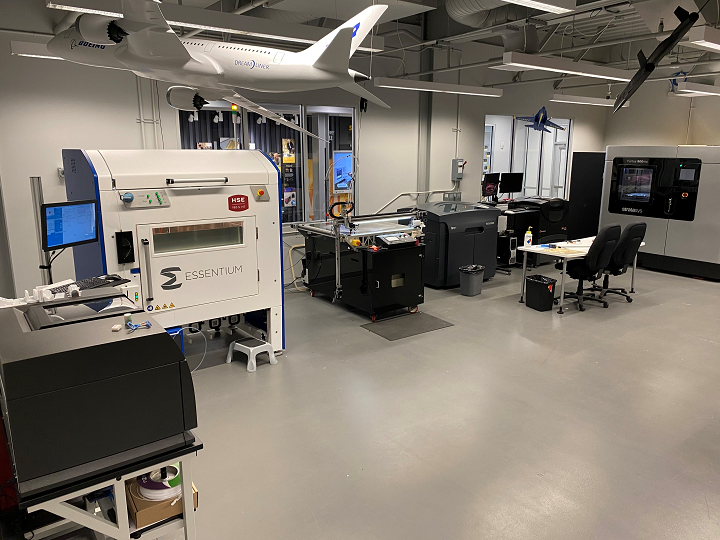National Institute for Aviation Research to Advance 3D Printing in Aerospace with Essentium’s High Speed Tech
Industrial 3D printing solutions provider Essentium, Inc., which recently announced an expansion in order to help satisfy growing demand for its High Speed Extrusion (HSE) platform across Asia, North America, and Western Europe, has just revealed a new commercial venture with Wichita State University’s National Institute for Aviation Research (WSU/NIAR) in order to speed up the advancement of 3D printing in the US aviation industry. Through collaborative research, the two will use a multi-stage process to advance extrusion AM so it benefits the overall aerospace industry, and, according to an Essentium press release, “harness 3D printing for speed to aircraft part, safety, and performance.”
“Up until just a few years ago, AM technology wasn’t at the point where it could make parts that were precise and durable enough for safety-critical aircraft parts,” John Tomblin, WSU Senior Vice President for Industry and Defense Programs and NIAR Executive Director, said in the release. “Technology advancements from AM innovators like Essentium have transformed the manufacturing possibilities for the aviation industry and significantly decreased time-to-market.”
This new collaboration is part of the Kansas Aviation Research and Technology Growth Initiative (KART), which chooses programs to help the future of innovation in the aerospace industry and includes several other aviation companies from around the state, such as Airbus, Spirit AeroSystems, Bombardier Learjet, and Textron Aviation.
This isn’t the first time that NIAR, which has its own Additive Manufacturing Lab, has collaborated with a 3D printing company—in the past the institute has worked with RIZE, Airbus and Dassault Systèmes, and even helped SAE International develop some new polymer 3D printing standards for the aerospace industry.
With this latest collaboration, NIAR and Essentium are working towards an end goal of helping aviation companies adopt additive manufacturing, as the technology can help slash product lead times and allow them to respond in a more rapid manner to market changes.
“By combining our 3D printing platform and materials with NIAR’s industry-specific knowledge and direct feedback from the KART members, we aim to create meaningful AM applications to help aviation companies rapidly produce parts on-demand, save money, reduce waste, and streamline the supply chain,” stated Josh Lawson, Essentium’s Sr. Dir. Business Development. “Until now, the industry has been limited by the lack of choice in trusted industrial-scale AM solutions. We’re honored to collaborate with NIAR and members of KART in Wichita to be part of next generation solutions for aerospace and defense, helping the industry move forward to new levels of innovation and efficiency.”
Essentium’s super-fast, open HSE platform, which first hit the scene at RAPID + TCT 2018 and was formally launched later that year at formnext, gives aviation companies more flexibility in 3D printing hundreds of aircraft parts, due to the fact that it offers more material choices in terms of color and texture. As part of the company’s new commercial venture with NIAR, the company’s engineers will be calling on their materials science expertise to tune these materials so they process at speed, as well as being strong enough to protect electrostatic-sensitive devices and hold up under impact loading and fatigue.
Initially, the NIAR team will be relying on the HSE platform’s repeatability, performance, and safety to produce spare parts, keep older aircraft in the air, and come up with new and improved designs for future aircraft systems, as well as certify new materials for use in the aviation field. In the future, the collaboration between Essentium and NIAR could lead to other applications, such as flight-worthy end parts and tooling.
(Source/Images: Essentium)
Subscribe to Our Email Newsletter
Stay up-to-date on all the latest news from the 3D printing industry and receive information and offers from third party vendors.
You May Also Like
Precision at the Microscale: UK Researchers Advance Medical Devices with BMF’s 3D Printing Tech
University of Nottingham researchers are using Boston Micro Fabrication‘s (BMF) 3D printing technology to develop medical devices that improve compatibility with human tissue. Funded by a UK grant, this project...
3D Printing Webinar and Event Roundup: April 21, 2024
It’s another busy week of webinars and events, starting with Hannover Messe in Germany and continuing with Metalcasting Congress, Chinaplas, TechBlick’s Innovation Festival, and more. Stratasys continues its advanced training...
3D Printing Webinar and Event Roundup: March 17, 2024
It’s another busy week of webinars and events, including SALMED 2024 and AM Forum in Berlin. Stratasys continues its in-person training and is offering two webinars, ASTM is holding a...
3D Printed Micro Antenna is 15% Smaller and 6X Lighter
Horizon Microtechnologies has achieved success in creating a high-frequency D-Band horn antenna through micro 3D printing. However, this achievement did not rely solely on 3D printing; it involved a combination...

































